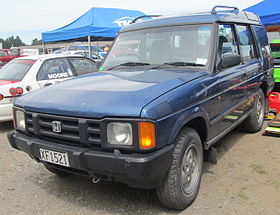auto.wikisort.org - Automobile
The Honda Crossroad (Japanese: ホンダクロスロード, Honda Kurosurōdo) is an automobile nameplate used by two SUVs sold by Honda. The first one is a rebadged Land Rover Discovery sold in Japan between 1993 and 1998,[1] while the other is a vehicle developed by Honda for the Japanese market that was introduced in 2007.
| Honda Crossroad | |
|---|---|
 | |
| Overview | |
| Manufacturer | Honda |
| Production | 1993–1998 2007–2010 |
| Body and chassis | |
| Class | Compact SUV (1993–1998) Subcompact crossover SUV (2007–2010) |
| Body style | 5-door SUV |
| Layout | FR/4WD FF/4WD |
| Chronology | |
| Successor | Honda CR-V |
First generation (LJ/LJJ; 1993)
| First generation (LJ/LJJ) | |
|---|---|
 | |
| Overview | |
| Also called | Land Rover Discovery Series I |
| Production | 1993–1998 |
| Body and chassis | |
| Class | Mid-size SUV |
| Body style | 5-door SUV |
| Layout | Front-engine, rear-wheel-drive Front-engine, four-wheel-drive |
| Powertrain | |
| Engine | 3.9 L Rover 3.9 V8 (gasoline) |
| Power output | 182 hp (136 kW) |
| Transmission | 4-speed automatic |
| Dimensions | |
| Wheelbase | 2,540 mm (100.0 in) |
| Length | 4,535 mm (178.5 in) |
| Width | 1,800 mm (70.9 in) |
| Height | 1,950 mm (76.8 in) |
| Curb weight | 1,970 kg (4,340 lb) |
| Chronology | |
| Successor | Honda CR-V |
Honda marketed the Crossroad in the Japanese market from October 1993 to 1998 before replacing it with the CR-V.[2][better source needed][3][4][5] To date, the Crossroad is the only production vehicle sold by Honda to ever have a V8 engine.
Problems had emerged regarding the marketing of the Crossroad in Japan. For instance, Honda had threatened to end ties with Rover after the news that it was going to be sold to BMW.[6] Since the Crossroad was a rebadged Land Rover Discovery, it also had Land Rover's mechanical and reliability issues carried over. In 1997, a recall was issued by Honda on the advice of Ministry of Transportation due to a malfunction locking mechanism on the SUV's driver-side front door that could make the vehicle open while driving.[7] Around 4,754 vehicles made from July 1995 to December 1996 were affected by the recall.[7]
Second generation (RT; 2007)
| Second generation (RT1) | |
|---|---|
 | |
| Overview | |
| Production | 2007–2010 |
| Designer | Naohiro Kitazono and Yosuke Tokoro[8] |
| Body and chassis | |
| Class | Compact SUV |
| Body style | 5-door SUV |
| Layout | Front-engine, front-wheel-drive Front-engine, all-wheel-drive |
| Related | Honda Stream (second generation) |
| Powertrain | |
| Engine | 1.8 L I4 (gasoline) 2.0 L I4 (gasoline) |
| Transmission | 5-speed automatic |
| Dimensions | |
| Wheelbase | 2,700 mm (106.3 in) |
| Length | 4,285 mm (168.7 in) |
| Width | 1,775 mm (69.9 in) |
| Height | 1,669 mm (65.7 in) |
| Chronology | |
| Successor | Honda Vezel Honda CR-V |
The Crossroad name was resurrected as a new crossover SUV for the Japanese market in February 2007. The vehicle combines the exterior design of an SUV with the convenient size of a compact car and the 3-row seating and 7-passenger capacity.[9] The Crossroad is designed for people to enjoy their active new lifestyles, targeting young couples in their 20s and 30s with small children.[9][10]
Under the hood, the Crossroad sports one of two straight-4 engines of 1.8 L and 2.0 L in displacement. Both will be mated to the only available transmission: a 5-speed automatic. Honda's Real-Time AWD system has been thoroughly revised for the Crossroad. It now works in conjunction with stability and traction control as well as ABS brakes. For the first time in a Honda, the Crossroad will be equipped with Hill-Start Assist which temporarily maintains brake pressure after the brake pedal is released when starting on a hill. Under normal driving conditions, the Crossroad behaves as a FWD vehicle.
According to AutoWeek, Honda said it won't import the Crossroad to North America, since their similarly sized Element takes its place.[11] Honda's crossover SUV lineup in the United States and Canada already has the Element, the mid-priced CR-V and the larger Pilot, as all three models are made in North America.
It was reported that Honda did not export the Crossroad to Europe because of a voluntary commitment by the Japan Automobile Manufacturers Association to reduce average CO2 emissions in its European fleet to 140 grams per kilometer by 2009.[12] As a result, Honda was reluctant to offer larger vehicles without technological breakthrough.[12]
On August 25, 2010, Honda announced the discontinuation of the Crossroad.[13]
- Rear view
- Interior
References
- "Unofficial Discovery Page". Archived from the original on 2006-05-03. Retrieved 2009-04-20.
- "FIRST LOOKS: Honda Crossroad". Motor Trader. Archived from the original on 2012-03-01. Retrieved 2010-08-06.
- "Honda Crossroad: Top Nine Whacked-Out Automotive Rebadges Gallery". Archived from the original on 2008-10-16. Retrieved 2009-04-20.
- Michael Harrison (1994-02-22). "Divorce will cost both partners dear". The Independent. Retrieved 2009-04-20.
- Michael Harrison (1993-11-08). "Land-Rover on track to enter new pastures: Michael Harrison on a breakthrough that reverses the European trend of laying off workers". The Independent. Retrieved 2009-04-20.
- Michael Harrison (1994-02-03). "Honda to decide next week if it will sever ties with Rover". The Independent. Retrieved 2009-04-20.
- Paul Dever (1997-02-24). "Rover Japan Recalls Land Rover Discovery and Honda Crossroad". Kyodo News. Retrieved 2009-04-20.
- https://pdki-indonesia.dgip.go.id/index.php/di/RkJYYWlhZDNadXl4cnVYMXhMWWJPUT09?q=mobil&type=1&skip=80 [dead link]
- Nicusor, Blas (22 February 2007). "2007 Honda Crossroad (Feb 22, 2007)". www.topspeed.com. Retrieved 15 August 2019.
- Terada, Shinichi (23 February 2007). "Honda tries to reverse sales decline with Crossroad SUV". The Japan Times Online. Retrieved 15 August 2019.
- "Crossroad Won't Cross Over". AutoWeek. Archived from the original on August 4, 2011. Retrieved February 27, 2007.
- Treece, James (5 March 2007). "CO2 rules keep Honda's Crossroad out of Europe". Automotive News Europe. Retrieved 15 August 2019.
- "Crossroad Discontinued". Honda Japan. Retrieved August 25, 2010.
На других языках
[de] Honda Crossroad 2
Der Honda Crossroad bezieht sich auf zwei bestimmte Arten von SUVs. Das erste Modell war ein mittels Badge-Engineering des Land Rover Discovery Serie I größerer Honda Crossroad 1 SUV als das völlig andere 2007 eingeführte Fahrzeug.- [en] Honda Crossroad
[fr] Honda Crossroad
Lancé en mars 2007, le Honda Crossroad est un modèle du constructeur automobile japonais Honda. Descendant du HR-V, qui fut diffusé en Europe, le Crossroad est essentiellement réservé au marché japonais (il peut aussi se rencontrer sur quelques marchés asiatiques où la circulation se fait du côté gauche).[it] Honda Crossroad
La Honda Crossroad è un'autovettura prodotta dalla casa automobilistica giapponese Honda a partire dal 2007 al 2010.[ru] Honda Crossroad
Honda Crossroad (яп. ホンダ・クロスロード, Хонда Кроссроад) — два кроссовера, выпускавшиеся в разные годы концерном Honda. Одним из них является автомобиль, продававшийся под маркой внедорожника Land Rover Discovery Series I в 1990-е годы,[1] а второй, абсолютно другой автомобиль для внутреннего японского рынка, представленный в 2007 году на Токийском автосалоне и выпускавшийся вплоть до 2010 года. Последний позиционируется как замена модели HR-V.Другой контент может иметь иную лицензию. Перед использованием материалов сайта WikiSort.org внимательно изучите правила лицензирования конкретных элементов наполнения сайта.
WikiSort.org - проект по пересортировке и дополнению контента Википедии

